For more than a century, NEA’s members have joined together with families and community leaders to advocate for our students and our public schools.
And along the way, we’ve accomplished quite a bit.
Take a look at what we can do together when we speak up for students and educators.
2023
December
Federal bench diversifies—personally and professionally
Nearly two-thirds of the federal judges appointed by President Biden are women, and the same share are members of racial or ethnic minority groups, according to a Pew Research Center analysis. Among those singled out for support by NEA are Nancy Abudu, confirmed to the U.S. Court of Appeals for the Eleventh Circuit; Casey Pitts, confirmed to the U.S. District Court for the Northern District of California; and Nusrat Choudhury, confirmed to the U.S. District Court for the Eastern District of New York.
November
House committee holds first GPO/WEP hearing in years
The push for repeal of GPO and WEP gained momentum at a field hearing in Baton Rouge, Louisiana, convened by the House Ways and Means Committee. The bipartisan Social Security Fairness Act (S. 597/H.R. 82) that would fully repeal both GPO and WEP has more than 300 cosponsors in the House and 49 in the Senate.
October
Billions of dollars in student debt cancelled
The Biden administration announced that it has approved cancellation of $127 billion in debt for nearly 3.6 million borrowers, including $51 billion for 715,000 public servants through Public Service Loan Forgiveness (PSLF). The administration also announced that nearly 5.5 million borrowers have enrolled in the Saving on a Valuable Education (SAVE) plan, including 2.9 million with $0 payments.
August
NEA launches successful effort to defeat draconian cuts
Cuts in education funding proposed by the House GOP would be the most extreme ever to reach the House floor. They include eliminating more than 50,000 Head Start slots, slashing Title I funding by 80 percent, and crippling programs for English learners. The House GOP's bill would also wipe out as many as 224,000 educator jobs, leading to larger class sizes and less individual attention—the opposite of what today’s students need. NEA, our members, and allies conveyed these facts, forcing Speaker Mike Johnson to pull the bill from the floor when it did not have enough votes to pass.
May
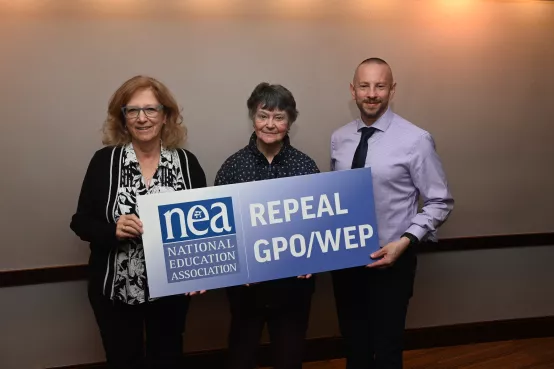
NEA members come to Washington to lobby for GPO/WEP repeal
Educators from all 15 states affected by GPO and WEP flew to Washington to lobby for their repeal. Together, GPO and WEP deprive more than 2.7 million educators and other dedicated public servants of Social Security benefits they have earned.
2022
December
Year-end funding bill includes Electoral Count and Pregnant Workers Fairness Acts
The 117th Congress passed a year-end funding bill with provisions to help educators, students and families, including the Electoral Count Act to ensure that the electoral votes tallied by Congress accurately reflect the people’s vote in each state. The bill also includes the Pregnant Workers Fairness Act, which would create a uniform national standard for reasonable accommodations for pregnancy, childbirth, and related conditions.
December
Landmark marriage equality legislation becomes law
The bipartisan Respect for Marriage Act recognizes the marriages of same-sex and interracial couples, so long as their marriages were valid in the state where they were performed. It also preserves state and federal benefits for these marriages, should the courts open the door to future legislation prohibiting them.
August
Inflation Reduction Act helps students and families
On August 16, President Biden signed the Inflation Reduction Act into law. The most significant climate investment in U.S. history, the bill also makes healthcare more affordable by reducing prices for certain prescription drug prices and capping the cost of insulin.
August
New student-debt cancellation plan unveiled
A new student-debt cancellation plan announced by the White House could forgive up to $20,000 in federal student debt for each borrower. This victory is on top of the Temporary Public Service Loan Forgiveness Waiver that delivered $24 billion in loan forgiveness for 360,000 public-service workers over the course of a year. (Need help navigating your student debt? Here's what you need to know.)
June

Significant gun violence reform enacted for first time in 30 years
President Biden signed the Bipartisan Safer Communities Act into law on June 25. The first significant gun safety package in almost 30 years, it enhances background checks for gun purchasers under 21 and broadens access to mental healthcare, especially school-based programs. The bill also encourages states to implement red flag laws that temporarily keep individuals at elevated risk of harming themselves or others from gaining access to guns.
NEA President Becky Pringle testified at a House Oversight and Reform Committee hearing on June 8 and said, “Our country has already experienced nearly 240 mass shootings in 2022. But that number does not begin to capture the scope of this epidemic. Every day, gun violence kills 111 people. That means we can expect 22,255 more deaths by gun this year. Inaction equals acceptance of the unacceptable.”
April
Justice Ketanji Brown Jackson Joins Supreme Court
Ketanji Brown Jackson is the first Black woman and public defender to serve on the U.S. Supreme Court. NEA members supported her nomination because of her impeccable credentials and to help ensure that our justice system reflects the very best of America.
March
Violence Against Women Act reauthorized
The Violence Against Women Reauthorization Act maintains protections for victims, makes vital investments in preventing sexual assaults, protects victims of domestic violence from intimate partner homicide, and increases victims’ access to safe housing and economic stability. It also strengthens the law by closing the “boyfriend loophole” and barring people convicted of abusing, stalking or assaulting a dating partner from purchasing or owning a firearm, a provision that also applies to people under a court-issued restraining order.
Testimony in Congress
NEA helps educators lift their voices and lend their expertise in the halls of power.
2000-2021
2021
Infrastructure Investment and Jobs Act signed into law
The legislation represents a historic investment in roads and bridges, along with broadband funding. It also extends the Secure Rural Schools Act, works to eliminate lead pipes in schools and childcare facilities, and invests in electrifying school buses to reduce emissions.
2021

NEA members win debt cancellation for hundreds of thousands of public service workers
After hearing from thousands of NEA members across the country, the Department of Education announces much needed reforms in the Public Service Loan Forgiveness (PSLF) program. The changes include a temporary waiver providing imminent relief for tens of thousands of public service workers, like educators, and eventual relief for hundreds of thousands of borrowers. Previously, the broken PSLF program denied 98 percent of the applications filed and forgave just 16,100 borrowers.
2021
NEA helps pass COVID-19 Hate Crimes Act
NEA members rally to protect Asian Pacific Islanders from hate crimes and discrimination spurred by the pandemic. The law strengthens federal efforts to address these crimes in multiple ways.
2021
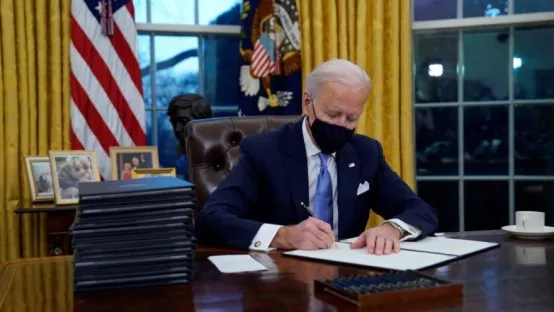
Biden’s American Rescue Plan prioritizes public schools
The single largest investment in public education in U.S. history, the American Rescue Plan includes all three of NEA’s top priorities: $170 billion in dedicated education funding for K-12 schools and higher education; $350 billion in state and local aid to help avoid further layoffs of educators and other essential public servants; and $7.2 million in emergency funding for the Federal Communications Commission’s E-Rate program to equip students to do schoolwork at home.
2020
Health care benefits protected
NEA urges the Supreme Court to uphold the Affordable Care Act and safeguard the health and safety of students and families; the Court agrees.
2019
Education Support Professionals honored federally after a decade of lobbying
The Recognizing Achievement in Classified School Employees Act, passed with bipartisan support, establishes the Recognizing Inspiring School Employees (RISE) Award for excellence in providing services to pre-K to grade 12 students and schools.
2019
Affordable Care Act’s 40 percent tax on “high cost” health plans repealed
Scheduled to take effect in 2022, this tax burden would have been borne by the 180 million Americans with employer-sponsored health coverage—including many educators—in the form of benefit reductions, higher deductibles, or both.
2018
#RedForEd movement shows educator power
The national #RedForEd movement begins in West Virginia, with educators striking in response to low salaries and rising healthcare costs. Educators in California, North Carolina, Arizona, Colorado, Oklahoma, Kentucky, and other states joined in the following two years.
2015
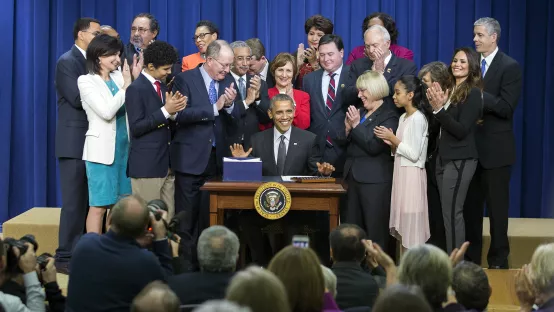
Educators cheer for passage of The Every Student Succeeds Act
Educator activism and lobbying leads to the replacement of No Child Left Behind. The Every Student Succeeds Act meets all three of NEA’s core goals: an “opportunity dashboard” to help ensure equity and opportunity for all students, less standardized testing decoupled from high-stakes decisions, and empowering educators by giving them a voice in federal, state, and local decision-making.
2015
Educator tax deduction made permanent
In recognition of the money that educators spend from their own pockets to equip classrooms, the $250 educator tax deduction is made permanent and indexed to inflation.
2012
Deferred Action for Childhood Arrivals (DACA) protects thousands of educators
On June 15, the Secretary of Homeland Security announced that people who were brought to the United States as children and meet several guidelines may request consideration of deferred action for two years, subject to renewal. They are also eligible for work authorization, and many become educators!
2010
$10 billion Education Jobs Fund created by Congress
After the Great Recession of 2008, this fund saved the jobs of an estimated 138,000 educators coast to coast.
1971-1999
1990
IDEA amended to protect the rights of students
The Individuals with Disabilities Education Act promises to make a “free appropriate public education” available to children and young people with disabilities and to provide special education and related services.
1979
Department of Education elevated to Cabinet
Following years of intense lobbying efforts by NEA, the United States Department of Education is elevated to full cabinet status, helping to provide and regulate education nationally.
1975

Education for All Handicapped Children Act becomes law
With the activism of NEA members, President Gerald Ford signs the civil rights measure into law, guaranteeing access to education for every child.
1974
The U.S. Supreme Court defends rights of working women
NEA wins a Supreme Court case striking down mandatory maternity leave for pregnant teachers.
1972
NEA forms the NEA Fund for Children and Public Education
The political action committee allows NEA to influence the national legislative agenda, shape electoral platforms, and lend support to candidates with positions favorable to public education, regardless of party. Funded by member contributions, it becomes one of the nation’s largest and most influential PACs.
1971
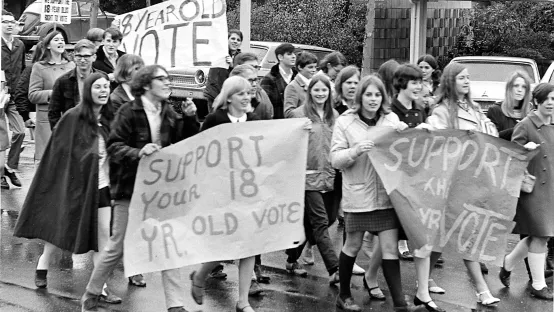
Aspiring educators helped lower the voting age to 18
Student Educators launch Project 18, a national campaign to change the voting age to 18. Activists work to pass the 26th Amendment, which allows millions of young people to participate in the democratic process and to have a powerful voice in shaping their political future.
Celebrating the Passage of the 26th Amendment
1950-1970
1967
NEA members elect first Hispanic president, advocate for local funding
Braulio Alonso becomes NEA’s first Latino president. NEA begins a drive for multicultural instruction and improved the representation of people of color in textbooks.
1965
Title I regulations support students
Title I of the Elementary and Secondary Education Act seeks to level the playing field for the most vulnerable students, including poor children, students with disabilities, and English-language learners. The same year, an NEA-produced film, “Children Without,” is nominated for an Academy Award.
1965
President Lyndon Johnson signs ESEA
Johnson is named an NEA Honorary Life Member for signing the Elementary and Secondary Education Act, the cornerstone of the federal presence in K-12 education. The law represents a commitment to equal access to education for students regardless of ZIP Code.
1954

NEA and American Teachers Association join to recruit and retain educators of color
Following Brown v. Board of Education decision, NEA establishes a $1 million fund—more than $10 million in today’s dollars—to “protect and promote the professional, civil, and human rights of educators,” and worked with ATA to support educators of color and retain them in the profession.
NEA and ATA Join Forces
Pre-1950
1948
NEA helps eliminate race-based salary schedules
NEA and ATA provides data to the Supreme Court in a case that found dual-salary schedules based on race unconstitutional.
1946

President Truman sign the National School Lunch Act into law
The lives of students from lower-income families are improved once Congress began providing grants to states to ensure that all schools could provide lunch.
1945
Educators win rights to political activism
The Hatch Act previously banned all public employees from political activity, but the amendment allows teachers and NEA to participate in public affairs.
1945
NEA members secure first collective bargaining agreement
NEA members in Norwalk, Conn. go on strike and secured the first-ever collective bargaining agreement for educators.
1944-45
NEA protects educator activism at the ballot
Kate Frank, a local teacher activist in Muskogee, Okla., is terminated for supporting a school board candidate. After NEA wins her case, she is reinstated and the Association initiates the Kate Frank/DuShane Fund to defend other wrongfully terminated educators.
1935
School construction is included in Works Progress Administration
Because of educator advocacy, hundreds of school buildings are constructed with federal funding.
1926
NEA supports accreditation for schools serving Black students
In the 1920s, the Southern Association of Schools and Colleges (SASC) did not accredit schools for Black students, severely limiting their access to higher education. NEA joines with the American Teachers Association to pressure SASC to change. The Joint Committee for Justice was the first of several successful NEA-American Teachers Association partnerships.
1919
NEA members create the first pension for educators
NEA member advocacy leads all states to create laws to provide funds for transporting children to school. That same year, NEA members in New Jersey creat the first pension for school employees.
1912
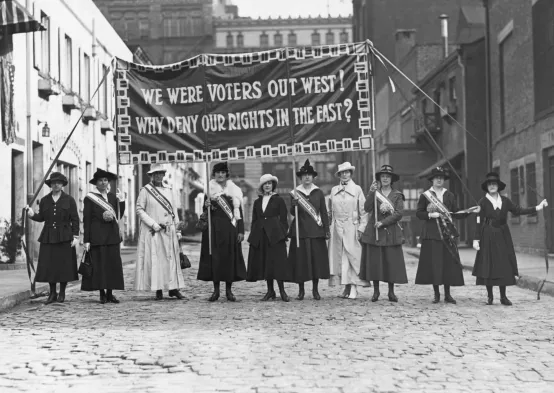
NEA votes to support the fight for Women’s Suffrage
Almost a decade before women are granted the right to vote, women educators are able to join NEA, vote in NEA elections, and run for office. Ella Flagg Young is elected the first woman president of NEA in 1910.
1906
NEA’s National Convention is Dedicated to Ending Child Labor
Educators lead the national conversation to end child labor, later supported and chartered by an act of Congress.
1887
NEA champions Retirement
NEA passes a resolution insisting on retirement plans for education employees in all states.
1865
NEA Denounces Slavery
At the summer convention, J.P. Wilkersham, president of the National Teachers Association (NEA’s forerunner), denounces slavery and recommends that no seceded states be readmitted to the Union until they agree to provide a free public school system for Black as well as white children.
1857
NEA is founded as the National Teachers Association
One hundred educators (from 10 state associations) meet with the mission “to elevate the character and advance the interest of the profession of teaching, and to promote the cause of popular education in the United States.”
OUR VOICE = POWER Speak Up for Public Schools
When we unite and speak truth to power, we can have an enormous impact. Stay up to date on the latest actions you can take to protect and improve public schools for all students.
